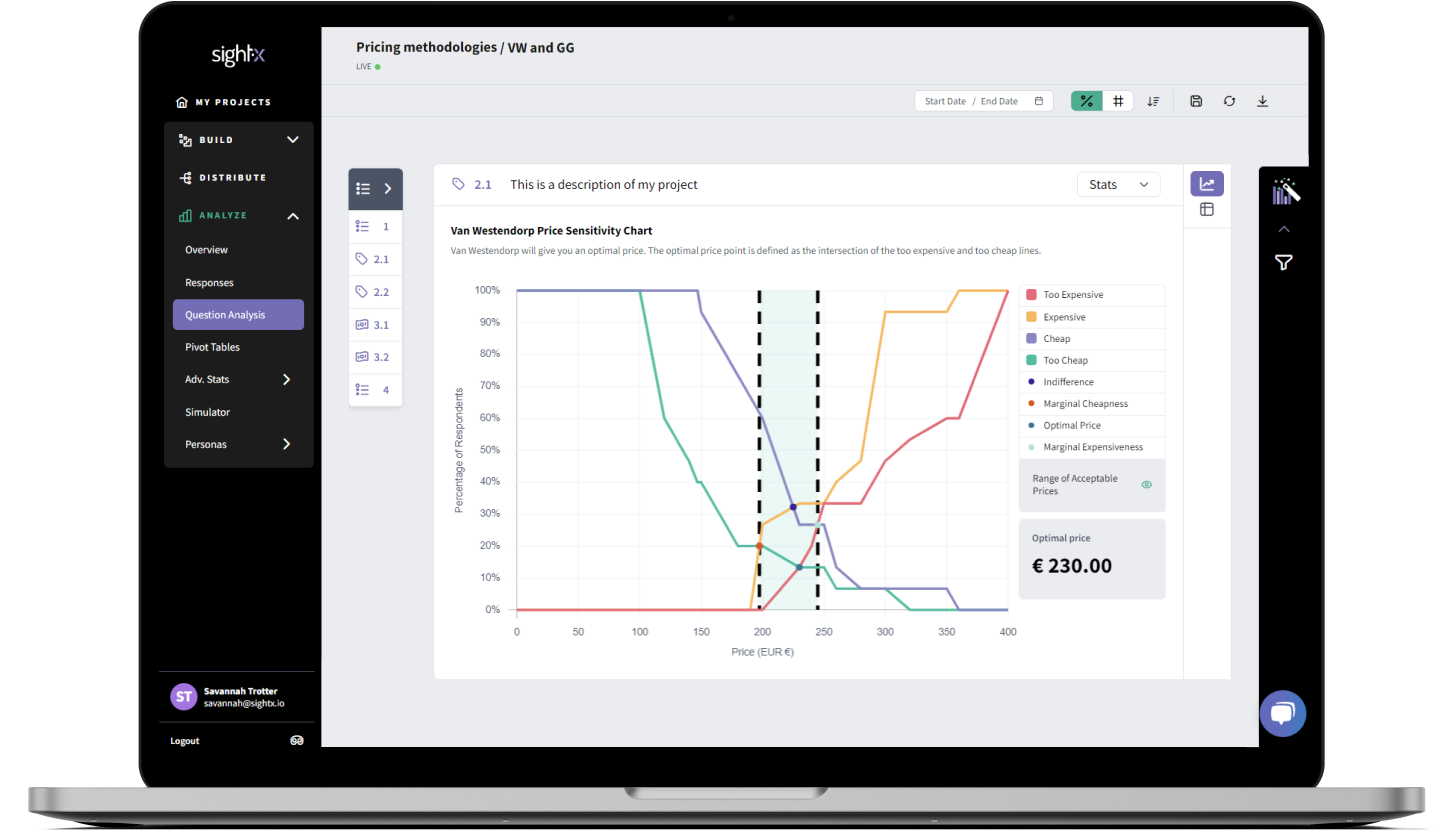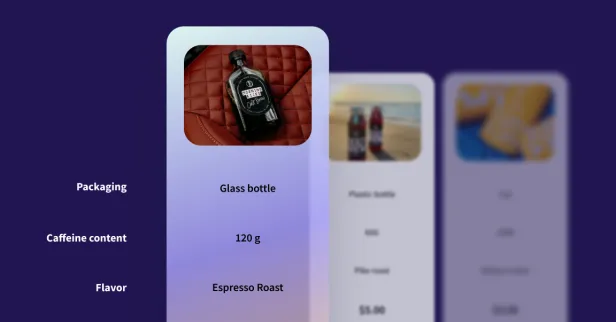As you likely know, determining the optimal price for your products or services requires more than just intuition. It demands a deep understanding of market conditions, customer perceptions, and competitor strategies.
That's where pricing analysis comes into play.
Today, we'll explore various pricing analysis methods and highlight seven key questions to ask in your own research.
What is a Pricing Analysis?
A pricing analysis systematically evaluates different pricing strategies to determine the optimal price point for a product or service. It involves assessing customer willingness to pay, cost structures, competitor pricing, and overall market conditions. The objective is to find a price that maximizes profitability while remaining attractive to customers.
Overall, pricing analysis helps organizations make informed decisions about setting initial prices for new products, adjusting prices for existing products, and responding to market changes.
Pricing Analysis Methods
You can use many methods for a pricing analysis, each offering unique insights and applications. Here are four commonly used methods:
Price Sensitivity Testing (Van Westendorp)
The Van Westendorp Price Sensitivity Meter is a technique used to gauge customer perceptions of price points for a product or service. It does this by asking respondents four key questions:
![]() At what price would you consider the product to be too expensive to consider?
At what price would you consider the product to be too expensive to consider?![]() At what price would you consider the product to be priced so low that you would question its quality?
At what price would you consider the product to be priced so low that you would question its quality?![]() At what price would you consider the product to be a good deal?
At what price would you consider the product to be a good deal?![]() At what price would you consider the product to be getting expensive but still worth it?
At what price would you consider the product to be getting expensive but still worth it?
By analyzing the responses, you can identify an acceptable price range that balances perceived value and affordability.

Price-Demand Analysis (Gabor-Granger)
The Gabor-Granger method involves presenting respondents with a series of price points for a product and asking how likely they are to purchase at each price. This helps you understand the relationship between price and demand, allowing you to estimate the potential sales volume and revenue at different price levels.
The key steps in a Gabor-Granger analysis include:
![]() Selecting a range of price points to test.
Selecting a range of price points to test.![]() Surveying a sample of the target audience.
Surveying a sample of the target audience.![]() Analyzing the responses to determine the price elasticity of demand and identifying the optimal price point that maximizes revenue.
Analyzing the responses to determine the price elasticity of demand and identifying the optimal price point that maximizes revenue.
Conjoint Analysis
Conjoint analysis is a more complex method that assesses how customers value different attributes of a product, including price. It involves presenting respondents with a series of product configurations and price points, asking them to choose their preferred options.
This test helps in understanding the trade-offs that customers make and the relative importance of each attribute.
Conjoint analysis provides insights into:
![]() How different product attributes, including price, influence customer preferences.
How different product attributes, including price, influence customer preferences.![]() The perceived value of each attribute.
The perceived value of each attribute.![]() The optimal combination of attributes and price that maximizes customer satisfaction and willingness to pay.
The optimal combination of attributes and price that maximizes customer satisfaction and willingness to pay.
.png)
Price Rating (Concept Testing)
Price rating involves evaluating customer reactions to a proposed price within the context of a product concept. This method is often used in the early stages of product development to gauge potential customer acceptance and willingness to pay.
In a price rating survey, respondents are typically asked to rate how reasonable they find the proposed price for a given product concept on a scale (e.g., from "very expensive" to "very cheap"). This helps you understand customer perceptions and identify a price point that aligns with their expectations.
Seven Pricing Analysis Survey Questions
If you want actionable insights from your pricing research, you'll need to ask the right questions. Here are a few key questions to include in your pricing analysis surveys:
1. At what price would you consider this product to be too expensive to consider? This question helps identify the upper limit of what customers are willing to pay, providing insights into perceived value and price sensitivity.
2. At what price would you consider this product to be priced so low that you would question its quality? Understanding the lower price threshold helps ensure that pricing is not set so low that it undermines the perceived quality of the product.
3. At what price would you consider this product to be a good deal? This question identifies the price point at which customers perceive the product as offering good value for money, which can help in setting a competitive price.
4. At what price would you consider this product to be getting expensive but still worth it? This helps determine the highest price point at which customers still find the product worth purchasing, providing a range for optimal pricing.
5. How likely are you to purchase this product at [specific price point]? This question helps gauge the likelihood of purchase at different price levels, aiding in understanding price elasticity of demand.
6. How would you rate the value of this product at [specific price point] on a scale from 1 to 10? Rating the value at different price points helps identify the perceived value and potential pricing sweet spots.
7. Which of the following product attributes are most important to you when deciding on a purchase? Understanding the importance of various product attributes, including price, helps in identifying the trade-offs customers are willing to make and the overall value proposition.
Why You Should Run a Price Analysis
Running a pricing analysis offers several benefits:
![]() Optimizing Revenue: By identifying the optimal price point, businesses can maximize revenue and profitability.
Optimizing Revenue: By identifying the optimal price point, businesses can maximize revenue and profitability.![]() Understanding Customer Perceptions: Pricing analysis provides insights into how customers perceive the value of your product and their willingness to pay.
Understanding Customer Perceptions: Pricing analysis provides insights into how customers perceive the value of your product and their willingness to pay.![]() Competitive Advantage: Knowing how your pricing compares to competitors helps you position your product effectively in the market.
Competitive Advantage: Knowing how your pricing compares to competitors helps you position your product effectively in the market.![]() Informed Decision-Making: Data-driven pricing decisions reduce the risk of setting prices too high or too low, ensuring that pricing strategies are based on solid insights.
Informed Decision-Making: Data-driven pricing decisions reduce the risk of setting prices too high or too low, ensuring that pricing strategies are based on solid insights.![]() Market Segmentation: Pricing analysis helps identify different segments of the market and their respective price sensitivities, allowing for targeted pricing strategies.
Market Segmentation: Pricing analysis helps identify different segments of the market and their respective price sensitivities, allowing for targeted pricing strategies.![]() Adapting to Market Changes: Regular pricing analysis helps businesses stay agile and responsive to changes in market conditions, customer preferences, and competitive dynamics.
Adapting to Market Changes: Regular pricing analysis helps businesses stay agile and responsive to changes in market conditions, customer preferences, and competitive dynamics.
Pricing Analysis with SightX
No matter the method you choose, SightX's tools make pricing analysis easier, faster, and more accurate than ever before.
By infusing the power of generative AI with advanced price analysis tools, you can:
![]() Create fully customized price analysis studies and experiments with a prompt, like: "I need to find the ideal price point for my product. Create a Gabor-granger study."
Create fully customized price analysis studies and experiments with a prompt, like: "I need to find the ideal price point for my product. Create a Gabor-granger study." ![]() Collect data from your target audience.
Collect data from your target audience.![]() Receive fully analyzed and summarized results in seconds, revealing key brand insights and personalized recommendations.
Receive fully analyzed and summarized results in seconds, revealing key brand insights and personalized recommendations.
Whether it's understanding the price sensitivity in your market, exploring demand fluctuations, or finding the ideal price point, SightX offers a comprehensive suite of pricing research features designed to streamline the process and deliver results fast.
Let us show you how simple it can be to collect powerful brand insights.
